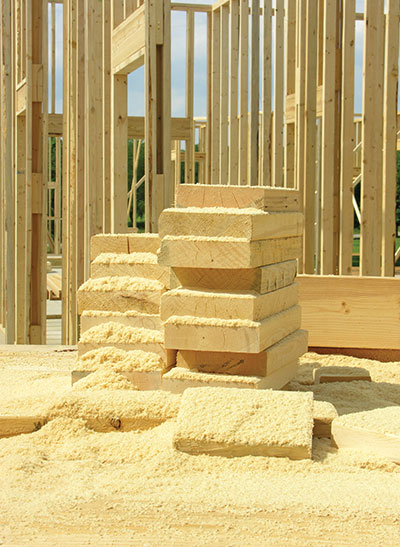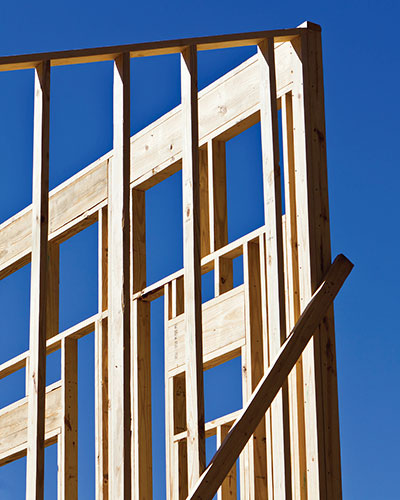
Features
Hot topics
Research
Best practices
A building is never more vulnerable to fire than during its construction – particularly when exposed wood is present.
August 1, 2014
By Len Garis and Joseph Clare
A building is never more vulnerable to fire than during its construction – particularly when exposed wood is present. But a growing focus on best practices in Canada and around the world could help reduce these risks and prevent the types of devastating construction-site fires seen in Richmond, B.C., in 2011 and Kingston, Ont., in December 2013.
 |
|
| Construction fire safety plans (CFSP) are typically developed by the site owner or representative in conjunction with the fire department, and are designed to address typical hazards that are present during construction. The leading causes of fire in buildings under construction or demolition are incendiary or suspicious events, smoking, open flames, embers and heating equipment.
|
The increasing recognition of construction-fire risks by government and the construction industry has led to a trend toward fire-safety plans for construction sites, which outline actions to be taken by site owners to reduce the likelihood and manage the impact of fires during construction and demolition.
This emphasis on best practices and fire-safety planning are positive steps for the fire service, particularly because of the growing interest in wood construction across Canada, and new research showing that the only increased fire risk associated with wood-frame buildings is during their construction (more on this research below).
Fire-safety regulations related to buildings under construction vary across the country. While the National Fire Code requires a fire-safety plan for all construction sites, not all provinces have adopted this aspect of the code. The NFPA 241 standard also provides measures to prevent and minimize fire damage in structures during construction, alteration and demolition, but this too is not universally followed.
In some cases, construction-fire safety has been addressed under occupational health and safety guidelines for construction sites, as it has in Ontario.
British Columbia and Alberta have taken a more proactive approach. Both provinces’ fire codes include requirements for fire-safety plans for construction sites, and some cities, including Delta and Surrey in British Columbia, have developed detailed bulletins to assist site owners with the development of these plans. Surrey’s bulletin has been referenced by the Canadian Wood Council for its education outreach with the construction industry.
The leadership on this issue emerging in Western Canada mirrors what is happening abroad. The United Kingdom introduced construction-fire safety regulations in 2007. The Confederation of Fire Protection Associations in Europe – its members span 18 countries – followed suit in 2012 with specific guidelines based on best practices.
Construction fire safety plans (CFSP) are typically developed by the site owner or representative in conjunction with the local fire department, and are designed to address the typical hazards that are present during construction. The leading causes of fire in buildings under construction or demolition are incendiary or suspicious events, smoking, open flames (e.g. from hot works, such as welding), embers and heating equipment.
CFSPs also consider available firefighting infrastructure, the potential and impact of fire spread within the site and to neighbouring properties, construction techniques, and unique issues related to each site and project.
At the very least, each plan should include consideration of:
- emergency procedures and information needed to plan for an emergency
- training of site personnel on evacuation procedures
- assigned site personnel who are responsible to install and maintain fire-safety duties
- firefighting services – hydrant, Siamese connection, sprinkler, access route
- fire extinguishers
- hot-works operations
- flammable and combustible storage
- electrical installations and petroleum gases
- security
- contact personnel
- building diagrams
Activities that can be critical to the success of each plan include:
Fire-safety training – including instruction in fire prevention and evacuation procedures for all workers, and adequate training (and retraining) for workers assigned to firefighting duties.
Passive protection – including provision at each floor level of an unobstructed stair discharging to grade level; co-ordination between the construction of fire compartments and fire walls; management of temporary heating equipment and roofing operations including heat sources; a high standard of housekeeping on site; maintaining fire-department access to the site; and providing a fire separation between occupied areas and areas under construction or demolition.
Fire protection – including an activated, charged standpipe and sprinkler system installed progressively with building construction; on-site fire protection stations; adequate water supply for fire protection; and a fire alert warning system.
Security and monitoring – alert, roving after-hours security personnel; and a fire watch during and after hot works operations.
Additional activities include installing doors in firewalls and closing them after hours, providing temporary water-flow alarms on sprinklers, providing sprinkler systems for exposure protection, and a pre-construction meeting between the local fire department and site representatives.
Complex sites should have a fire risk assessment that identifies time frames and measures related to increased risks.
A checklist of all activities may also be provided to assist site owners in the development of the CFSP.
 |
|
| Western Canada is leading the push for fire-safety plans for construction sites. Studies show that buildings are more vulnerable to fire during construction, particularly if exposed wood is present, but the sharing of best practices for construction-site safety is helping to change that.
|
Increased fire-safety measures at construction sites will help address the safety gap related to wood-frame buildings. A report released in February by the University of the Fraser Valley in British Columbia showed that while wood-frame buildings are as safe as those built with steel or concrete when fire-safety systems (e.g. working smoke alarms and sprinklers) are in place, they are more vulnerable to fires when they lack those systems – as is the case during construction.
Titled Fire Outcomes in Residential Fires by General Construction Type, the report compared 11,875 fires that happened between October 2008 and October 2013 in residential buildings with five different construction types: exposed wood joists and trusses, wood joists and trusses protected by plaster or gyproc, heavy timber, exposed steel or concrete joists and trusses, and steel or concrete joists and trusses protected by plaster or gyproc. (See Making the case for wood, Fire Fighting in Canada, May 2014)
The research indicated that if a building has effective fire-safety systems, the framing material has little impact on fire spread, death and injury rates. Therefore, improved construction fire safety planning is an important contributor to the overall safety of wood-frame buildings. (Read the full report at www.ufv.ca/cjsr.)
Leadership on this issue is required by the fire service at the national, provincial and local levels. Given the increased interest in wood construction across Canada – along with the fact that, ultimately, it is the fire service that responds to construction fires – it is incumbent on the fire service to begin pushing the decision makers to move forward with the necessary regulations, to ensure that best practices are used at construction sites in their own communities, and to advance the dialogue on wood-frame construction among the various stakeholders, from politicians to firefighters.
Greater harmonization among the stakeholders is the key to finding solutions that will ensure the next generation of wood buildings is as safe as possible.
(Download the City of Surrey’s Construction Fire Safety Plan Bulletin and checklist at www.surrey.ca/city-services/9624.aspx )
Len Garis is the fire chief for the City of Surrey, B.C., and an adjunct professor in the School of Criminology and Criminal Justice at the University of the Fraser Valley, Affiliated Research Faculty at John Jay College of Criminal Justice, New York, and a faculty member of the Institute of Canadian Urban Research Studies, Simon Fraser University. Contact him at LWGaris@surrey.ca.
Dr. Joseph Clare was the strategic planning analyst for the Surrey Fire Service between 2010 and 2013. He is an adjunct professor in the Crime Research Centre, University of Western Australia, and a faculty member of the Institute of Canadian Urban Research Studies (ICURS), Simon Fraser University. Contact him at joe.clare@uwa.edu.au.
Print this page